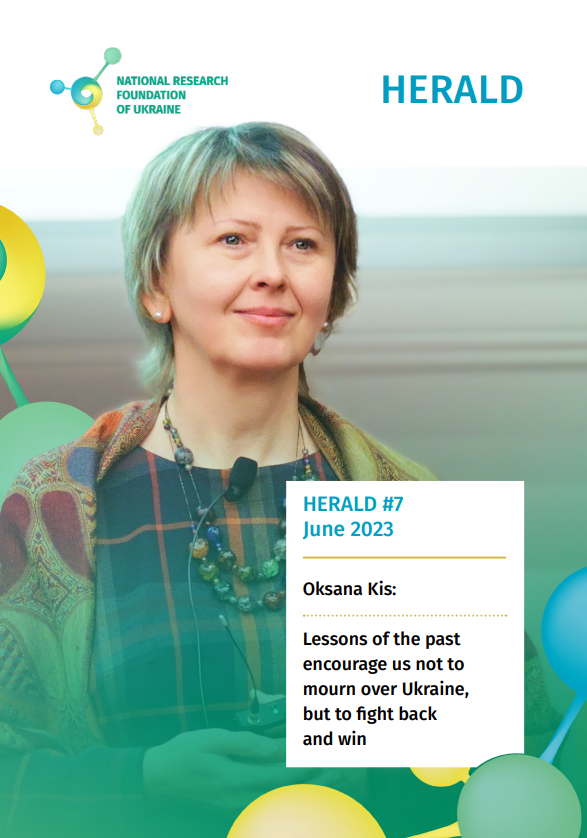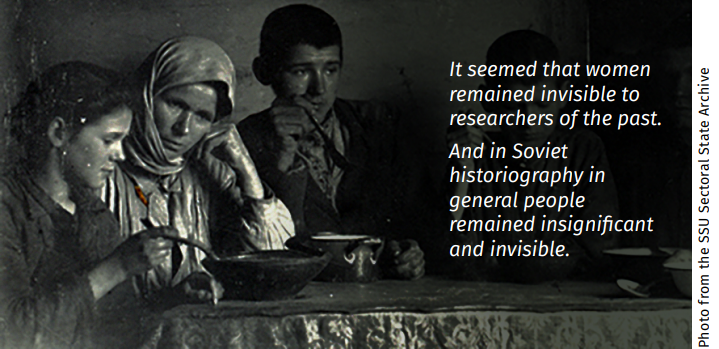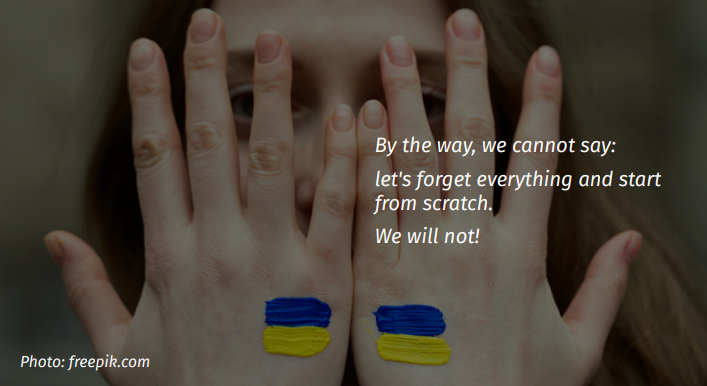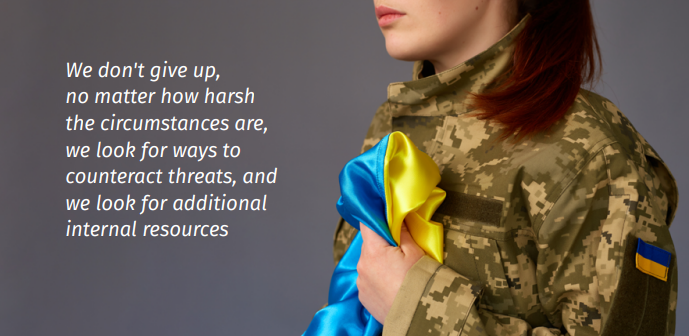
Oksana Kis, a historian, Head of the Department of Social Anthropology at the NASU Institute of Ethnology, Chairman of the Scientific Council of the Social Sciences and Humanities Section of the NRFU, explores Ukrainian history through the prism of women’s experience. The researcher’s paper “Women’s Experience of the Holodomor: Challenges and Ambiguities of Motherhood,” published in the Journal of Genocide Research, has recently been awarded the Robert Conquest Prize. This prize is awarded every two years by the Holodomor Research and Education Consortium (HREC) of the Canadian Institute of Ukrainian Studies (CIUS), University of Alberta for a significant contribution to the study of the Holodomor.
What are Ukrainian women capable of in the most difficult historical moments?
How did the Holodomor affect the current generation? Has it managed to overcome the past?
And how have Ukrainian women changed over the past decades?
We asked Oksana Kis these and other questions.
– Professor Kis, you have recently received a prestigious prize for your article “Women’s Experience of the Holodomor: Challenges and Ambiguities of Motherhood.” Please tell us a little more about this work. When and why did you decide to write it?
– I got interested in the experience of women during the Holodomor in the early 2000s, when I participated in the oral history project “Ukraine of the 20th Century in the Memory of Women.” Women of a very respectable age from three regions of the country talked about their lives. Almost all of them recalled the Holodomor, what they went through, how they survived.
In 2006, the Law of Ukraine “On the Holodomor of 1932-1933 in Ukraine” was adopted. It recognized the Holodomor as genocide of the Ukrainian nation. At the initiative of Viktor Yushchenko, enthusiasts, both amateurs and professionals, recorded memories of the Holodomor in different regions of Ukraine. A huge number of testimonies were published, but few people read or analyzed them. This was unfair to the people who shared their experiences. There were almost three times as many women’s stories, so I decided that it was worth exploring the women’s experience of this tragedy deeper.
– You talk about life experience of women in the article. That is, the focus is on the individual, not on the numbers of demographic losses. Why is it important to focus on people’s stories?
– I have always been interested in women’s history, in women’s experience of living through complex historical events (including the Holodomor). There was almost no written evidence about women’s daily lives and activities left. It seemed that women remained invisible to researchers of the past. And in Soviet historiography in general people remained insignificant and invisible.
Discussions about the Holodomor have long been centered on the numbers of demographic losses and the methods of calculating them. As an anthropologist, I was interested in the human dimension. I wanted to explore what exactly (day by day) happened to people who found themselves in critical circumstances.
When I started studying these testimonies, I quickly realized that they also contain a lot of information about resistance. People were trying to resist arbitrariness and defend their rights, even in conditions of total absence of civil rights.
I began to study what women did to survive. In the process of analyzing memories, certain behavioral patterns began to emerge: how they reacted, behaved, adapted, and countered. Back in 2010, I wrote and published an article about women’s experience of the Holodomor.
Once a colleague drew my attention to an important scientific journal, the Journal of Genocide Research. I decided to concentrate on the aspect of motherhood during the Holodomor. Studies on the gender aspects of the Holocaust helped me a lot in this work. It turned out that there are many similarities between Ukrainian women during the Holodomor and Jewish women during the Holocaust. The practices of adaptation and rescue, survival strategies, and circumstances (isolation, lack of resources, threat of death) of Ukrainian and Jewish women are very similar. The former found themselves in surrounded villages, without men, and the latter lived in segregated European ghettos…

– Which of the memories you have researched is most memorable to you?
– I research a large array of women’s memories and stories. As a rule, these testimonies are very fragmentary, often a single episode, a short story about an impressive and memorable experience.
Anastasia Lysyvets’s memoir was a true discovery for me. The book is freely available on the website of the Ukrainian Institute of National Remembrance. It is a sincere, meaningful, poignant story of a teenage village girl who survived and became a village teacher. She wrote her memoirs in the 70s-80s, at the request of her daughter. In my opinion, this is the Ukrainian equivalent of Anne Frank’s diary.
By the way, during my research I encountered several serious problems. One of them is the unprofessionalism of those who recorded those memories. Many people wrote down their memories without having the slightest idea of the interviewing methodology that allows to create a high-quality historical document – a personal testimony. The eyewitnesses of the famine were asked for dates, numbers, and names (for example, the name of the chairman of the collective farm or members of the towing teams that took away the grain in 1932). But few people remembered the names of the perpetrators decades later… Perhaps the eyewitnesses could have told more about their personal experiences, about the events they witnessed, but they were not asked about it…
Women were not asked what happened to women’s bodies, whether there were cases of sexual violence. Women were defenseless against the arbitrariness of the Bolshevik regime representatives, and empowered men abused this power and resources to punish or manipulate the female ‘kurkul’.
– What were the social and psychological consequences of the Holodomor? How did the man-made famine affect future generations of Ukrainians?
– There is a number of studies in the field of social psychology that show that the trauma experienced by survivors affects generations of their descendants. On the website of the Ukrainian Institute of National Remembrance there is a book by Iryna Reva “On the Other Side of Self: Socio-psychological and Cultural Con – sequences of the Holodomor and Sta – lin’s Repressions”. It is a popular science publication, but it is based on serious research.
Even if the Holodomor witnesses nev – er talked about their experiences, they still subconsciously passed this trau – ma on to their children. The phenom – enon of intergenerational transmission of trauma has been well researched in postmemory studies on the example of the Holocaust. These studies have made it clear that collective trauma is unfor – tunately ‘contagious’. Especially when it is silenced.
It turned out that the ‘conspiracy of si – lence’ about the horrors experienced was inherent in those who survived the Holocaust. They protected children from horrors and did not tell them anything. But the children felt their parents’ alert – ness and realized that something was wrong with this world, that the world was dangerous.
An unspoken trauma exerts a serious impact on life success of the descendants. The example of the descendants of Holocaust victims has shown that such people are more likely to have problems in social communications and personal relationships, depression, and high anxiety. And while the silence in Jewish families was compensated for by public recognition and discussion of the Holocaust, in the case of the Holodomor, heavy silence lasted for six decades. As a result, several generations of Ukrainians were poisoned by this toxic trauma.
The Holodomor’s consequences include attitudes toward the social environment. Traditional Ukrainian rural communities were a space of cooperation and mutual assistance. The Holodomor – and the Soviet regime in general – destroyed these networks, caused radical alienation and distrust in communities, and leveled the sense of community in many regions.
– Have Ukrainians managed to overcome this distrust?
– We are still overcoming these consequences.
The sense of solidarity and belonging to the community is now being restored. We understand who our enemy is, we understand that our strength is in unity and mutual support. We understand that the government, however imperfect, is on our side.
But I would not use the word “overcome”. You cannot fight your own past, you have to work with it. It is similar to individual psychotherapy: first, you need to see the problem, recognize it, disassemble it into fragments, comprehend each step, and think about how to get rid of the toxic consequences.
You cannot overcome the consequences, but you can change them.
By the way, we cannot say: let’s forget everything and start from scratch. We will not! Because what we are today is determined by what happened to our nation in the past. Not so long ago, just a few generations ago.
The war exacerbates all this. It is a painful process, but it is also faster. War makes us look into the abyss of the horror experienced by our ancestors. It’s scary and painful, but without it, we can’t move on.
For me, it was important to look at the human dimension, at the everyday life of the Holodomor. Because it seems to us that the Holodomor is an event. But this event lasted for two years, and people were trying to escape and survive all this time.
This approach allows us to see not only genocide and tragedy, but also resistance. We need to look at these events through the prism of resilience and survival strategies. We need to see not only death and loss, but also our ability to overcome challenges. People managed to survive the Holodomor, and this is a useful experience for us. It teaches us that we, as a nation, are able to survive even in such conditions.
To survive means to win. We survived the Holodomor, and we will survive this war. The lessons of the past encourage us not to mourn Ukraine and its tragic fate, but to know that we are capable of fighting back and winning.
Despite several centuries of persecution, oppression, and discrimination, we managed to maintain our resilience, gain independence, and revive our culture. Yes, today there is a threat again, but we will again demonstrate that despite the losses we are able to win.
This is how I suggest historians look at our past. I propose to look at Ukrainians as a nation that has risen from the ruins and ashes again and again. Although we were weak after each defeat, we were reborn and moved on.
– You study historical events through the experience of Ukrainian women. Tell us please how have Ukrainian women changed over the past decades? What traits and skills have they acquired?
– Both in the 1930s and today, Ukrainian women are very, very different individuals…
If we look at the current women’s volunteer movement, we will see some features that were characteristic of women during the Holodomor and among Ukrainian political prisoners in the Gulag. This is unwillingness to meekly accept the role of a passive victim and determination to stand up for what is right. We don’t give up, no matter how harsh the circumstances are, we look for ways to counteract threats, and we look for additional internal resources.
Many of today’s women volunteers have not previously participated in public initiatives. But now they feel the desire and ability to be citizens, to use their knowledge, skills and abilities (cooking, sewing, making camouflage nets, etc.) to contribute to the Victory. The volunteer movement is an incredible training for women, a powerful positive experience of cooperation and solidarity.
I believe that today we are seeing a powerful wave of awareness of active citizenship. It is important for people not only to have a Ukrainian passport, but also to act as citizens, to cooperate with their community and the state (even if the governmening structures are imperfect).
The war is terrible, but at the same time it gives every woman the opportunity to test her strength. To realize that she is capable of more, to believe in herself and to participate in decision-making. This experience is very important and will definitely be useful for the whole society during the post-war recovery.
– You are Chairman of the Scientific Council of the Social Sciences and Humanities Section of the NRFU. What challenges do you think the Foundation is facing today? Why is financial support on the competitive basis of fundamental and applied research important for the post-war recovery and research development?
– The Section of Social Sciences and Humanities is small in number (currently there are 8 people, and by the end of 2022 there were seven of us), and we represent the interests of very different disciplines – from philosophy, design and linguistics to economics, finance and state security. This diversity becomes a serious challenge when it comes to developing criteria for assessing the quality of research achievements. It is simply impossible to reduce the indicators of research achievements in completely different fields to one standard. To measure everyone by the same yardstick would mean not only ignoring the peculiarities of different fields of knowledge, but also neglecting the achievements that are indicators of progress in these fields.
We understand that the general “scopusization” has not worked in favor of the Social Sciences and Humanities, but has increased the level of corruption, pseudo-scientific activity, etc. Therefore, I believe that one of the main tasks of our section is to develop flexible and high-quality criteria for evaluating the research achievements of researchers and research teams. These criteria should adequately reflect the achievements and contributions to the development of the relevant field, the authority of the researchers themselves, and the weight of their work. In this sense, the joint initiative of the European Commission, Science Europe and the European Association of Universities aimed at reforming the principles and practices of evaluating research, researchers and organizations based on qualitative rather than quantitative indicators is encouraging. Last year, the Foundation became a member of the Research Assessment Reform Coalition (CoARA).
In fact, the NRFU began this work earlier, when the Scientific Council developed and implemented separate requirements for PIs of projects submitted to NRFU calls in the Social Sciences and Humanities. The weight of scientometric indicators was significantly limited, and they were replaced by more adequate criteria.
Actually, this brings me to the answer to the second part of the question – about the peculiarities of research funding in the context of the post-war recovery of the country. Given the critical shortage of resources, it is extremely important to use budget funds as rationally and efficiently as possible. This means that they should be allocated to those teams that actually work and generate new worldclass knowledge, respond to the needs of Ukrainian society, and offer effective solutions to the current problems faced by the country. For such funding, the grant approach is optimal. It is necessary to fund a specific project where a group of researchers works for a specific result. A fair and transparent call is a guarantee that the best of the best will receive the money – those who are willing and able to work in the conditions of crisis and offer original projects using the most modern theories and methodologies.
I believe that healthy competition is an incentive for the development of research, and fair competition encourages researchers to self-improvement, innovation, flexibility, and partnership. Unfortunately, the Soviet paternalism and the habit of expecting regular funding from the state budget regardless of performance are still firmly rooted in the NAS of Ukraine system. However, that era is over, and we need to live by the rules and principles on which research work is based in the world. This is the only way we can become a full-fledged part of the international research community.
Interviewed by Svitlana Galata

